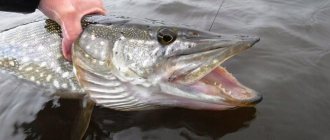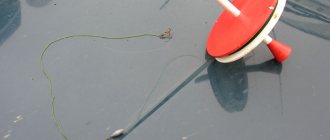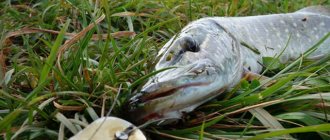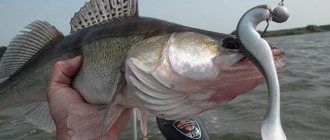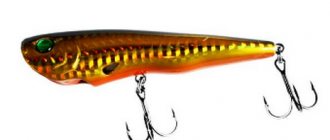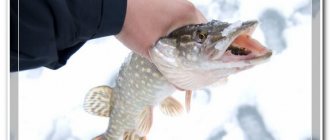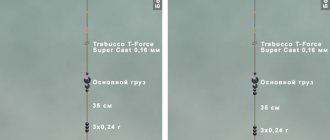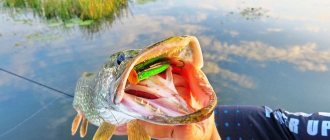Where to catch pike in June
Choosing a fishing spot is key, especially when fishing for predators. Pike is an ambush hunter. She waits for her prey near the grass, thickets of coastal bushes, in the reeds, below the border of the thermocline, above which small fish live.
There are two main criteria when choosing a place to catch June pike: the presence of fish that could potentially become prey, and a convenient place for an ambush. The presence of small fish can be easily checked visually, using an echo sounder or simply by throwing a small live bait fishing rod with a float into a place you like. If there are bites of roach, bleak, rudd, and crucian carp, it means that this place can potentially attract a predator.
Grass, snags, bushes, and shaded areas above water can act as an ambush. With the formation of a thermocline in the summer months, pike hunt throughout the entire area of the reservoir, waiting for prey from below. This is especially evident on lakes and ponds, where the thermocline forms early and there is no current. Large specimens prefer to stay close to the bottom, but in the summer months they are not very active, and their capture is more random. They should be caught in deep dumps, as well as in pits.
During the current, you should look for pike where it does not need to expend much strength to stay in place while waiting for prey. Usually these are all kinds of gates, bumpers, places with reverse flow or without it at all. In rivers, a thermocline is poorly formed and maintained due to the fact that the water is mixed. Therefore, here you should look for places for pike fishing directly near shelters and habitats of small fish.
When fishing for pike in June from a boat, more areas are available to the angler. Here it makes sense to position the boat in such a way as to cast the bait near the border of aquatic vegetation, or to use non-snagging hooks and cast right in the middle of the grass. Bottom jig is not very effective in summer. On the river, it is convenient to have two spinning rods - from one you fish by casting, rafting along the shoreline and throwing into the depths, and the other is used when returning as a path. Having made several such passes and remained without a bite, you should change the fishing area - it is quite likely that there are simply no fish here.
Spinning equipment for pike
For full-fledged pike fishing, a necessary step is the preparation of reliable equipment.
Some of the most important conditions for spinning equipment are:
- attaching the leash to the main line;
- attaching the bait through a swivel to the leash, which will help prevent the line from twisting;
- It would be a good idea to cover hooks for catching pike with feathers, but without excesses;
- If jig equipment is used, it is recommended to use offset hooks. This will help avoid getting caught in the algae.
Which spinning rod to choose for pike fishing
It is impossible to give definite advice here, since each spinning player has his own preferences. The choice of gear very much depends on the fishing location and bait. You can choose any rod structure, but for precise casting it is more convenient to use fast spinning rods. Pike are often caught in windows of vegetation using surface baits and non-hooking baits; fairly accurate casting is required there. The length of the rod is 2.2-2.4 when fishing from a boat and in normal conditions from the shore. When fishing among bushes and in other inconvenient places, as well as for special fishing methods, you can use a shorter spinning rod.
Read also:
- How to choose a good spinning rod;
- the best jig spinning rods;
- Twitching in shallow water is perfect for pike;
- We fish with ultralight.
The reel must lay the line well; this is a universal requirement for any reel, which gives the angler the opportunity to fish comfortably. The spool size is taken from 1500 and above. Taking ultralight reels and spinning rods for pike is not always possible, because fishing for pike with a spinning rod in June often takes place in the grass, and ultralight is not well suited for tearing out hooks. If you fish by twitching, by twitching the rod, then the requirements for the reel will be higher.
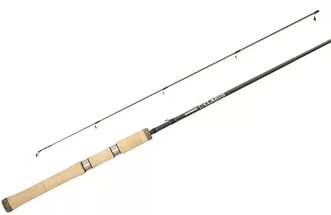
Line or cord? Abroad, fishing line is more popular due to its ease of use. The cord has taken root with us. For spinning, you should choose a good cord that has a coating. It will behave better with bait and will last a long time. However, when fishing with cranks, the line is too “hollow” in the hand, especially with large baits, and that is why many begin to switch to fishing line. It is advisable to use it of medium hardness, fluorescent color, so that if something happens it can be clearly seen and convenient to untangle. The thickness is usually taken at least 0.2.
A mandatory component of the equipment is a leash. The pike has sharp teeth; when fishing, it swings its open mouth, clinging to a fishing line or cord. It goes right over the teeth and can be easily cut. The length of the leash is taken from 10 to 30 cm. You can use both steel leashes, tungsten and titanium, and special leash materials. You can also make leashes yourself. After fishing, it is advisable to replace the rigid leash with a new one, since they usually wear out from bending and can then break at the most inopportune moment.
How to catch pike from the shore
From the shore in June, pike are caught using a spinning rod with a fan. The essence of the method is simple:
- The selected area is processed with a spinning rod of 7 casts. You can throw from left to right and vice versa.
- One cast is carried out in the water column, the other on the surface, one near the shore, the second in the distance.
- If after 7 casts there is no result, you need to change the spoon and try again.
- If there is no result, the fishing location changes.
After the bite, it is important to hook the pike correctly. If the fish is close to the shore, the hook is carried out sharply and quickly. When removing the pike from the shore, the hook also needs to be sharp, but wide.
If the fish resists, in order to avoid the line breaking, it is recommended to slightly loosen the line and lower the tip of the spinning rod into the water for a couple of seconds, and then continue fishing. The manipulation should be repeated until the pike gets tired. The fish is taken out of the water using a hook and by the gills. The hook is taken out with a yawner.
We also recommend reading:
Roach in June 2021: rules and features of fishing Fishing for crucian carp in June 2021: an unpredictable activity Catching perch in June 2021: an exciting and challenging activity Catching bream in June 2021: rules, tips, nuances
What to catch pike in June

When choosing bait, there is an important point to consider. Pike is a fairly voracious fish, and its usual food weighs about four to five times less. That is, a one-kilogram pike can calmly eat a two-hundred-gram rudd. When selecting bait, you should take into account the size that may interest it, but you should not go to extremes.
This is interesting:
- Rating of pike wobblers;
- The best budget wobblers for pike.
The two traditional and most popular baits are the crank and the spoon. It is good to fish with cranks from under the thermocline, and with spoons - near the grass. Among spinners, non-hooking ones are more often used, which allow you to fish in the most “pike” places near grass and snags. Lure color can make a difference in certain conditions, but when the fish are active and hungry in cloudy weather, it matters less.
Pinwheels are less common, but still sometimes used to catch this fish. Usually they install quite large ones with “lounge” type petals and all kinds of Chinese turntables with holes, clampless and others. The color of the bait can be important here and depends on the reservoir. Spinner spinners are good because they beat off the grass with a petal and provide fewer snags in shallow aquatic vegetation than regular spinners. When fishing with them, you should use shifting the rod from left to right to change the direction of movement of the spinner. This is a good way to provoke the fish to attack. With spinners you can immediately fish a large area of water both in the current and in still water.
Pike take well on all kinds of spinnerbaits and buzzbaits. They are good because they give few hooks, they can be fished both from the bottom and as surface baits. Such a universal bait can be used when exploring an unfamiliar body of water to determine the habitat of a predator, using a universal, medium-test spinning rod with a good reel. It is advisable to use a multicast here, because the load when wiring the reel from a pike spinnerbait can be large and the inertia-free spinnerbait will wear out greatly.
Jig is a popular fishing method. When fishing for pike, large twisters and vibrotails are used. They are rarely caught using worms. Pike mainly catch by evenly moving into the water floor, less often by dragging along the bottom. You can use a rig like a diverting leash, and in snags you can fish with a Carolina rig. When fishing from under a thermocline, it is important to match the weight of the load to the speed of the retrieve, so that the pike can calmly take aim and rush at the slowly moving bait, and so that it passes approximately on the border of warm and cold water.
Important! The best lures for pike - Top 10
Surface baits allow you to observe all fish bites live. They use poppers, walkers, all kinds of frogs and eggs. To fish with them, you need a light and fairly rigid rod-type spinning rod, which allows you to pull the bait and lead it in short jerks, and a good reel that reels smoothly even with varying line tension. It is more convenient to fish from a boat than from the shore.
Tackle
There are several requirements for a set of gear for pike fishing.
Spinning rod
To catch pike, you need to choose the right spinning rod:
- The choice of fishing rod directly depends on where the fishing will take place - from the shore or from a boat. Regardless of this, the angler is able to approach the fish at very close distances.
- When fishing for pike from the shore, a spinning rod 2.7 meters long would be an excellent option.
- When fishing from a boat, a 2.1 meter long rod is suitable.
- The spinning rod test depends on the baits used. So, for wobblers a test of 5 – 20 grams is ideal. And when fishing with a jig or a bulky spinner spoon, it is better to choose a test up to 40 grams.
- The most universal scale is Medium. To avoid mistakes, it is better to choose it.
When preparing tackle for pike fishing, you should take into account the parameters of the reel:
- The reel should not have any bells and whistles. It is best if it is as simple as possible.
- The size of the reel spool should be 2000 - 3000. The larger size (4000) is used for catching larger fish.
- The presence of a friction brake is very important. The ideal option would be a front drag in the reel.
- Choosing a modern baitcasting reel is the most suitable option even for beginners.
fishing line
Selecting the right fishing line is an equally important step in preparing fishing gear:
- When fishing with a jig, braided line works well. It will not stretch during the wiring process, which will allow you to know the exact location of the bait.
- For pike fishing, an ordinary line is ideal. After all, in any case, he will be “killed” by the end of the season. Therefore, you can choose even the cheapest cord, the diameter of which is 0.16–0.20 mm.
- Monoline is the least suitable option for catching pike. Of course, if an angler easily copes with such a design, then that’s another matter. But it’s always better to just enjoy fishing than to waste time twisting the line and so on.
Leash
To successfully fish for pike, you must have a leash. This piece of gear is needed to prevent predatory fish from biting the fishing line.
There are several types of leashes:
- steel;
- titanium;
- tungsten;
- Kevlar.
When choosing a leash, the material from which it is made does not really matter. But you should remember that it is better not to save even on this part of the gear set.
The leash can also be made by yourself. An ordinary guitar string will do for this. You just need to twist one edge into a loop to which the fishing line will be tied. And on the other end you need to put a swivel with a clasp, and then twist it too.
Thus, any metal leash will be a real salvation from line breaks.
Useful tips
- It’s convenient to wade fish from the shore using boots or even just going into the water in swimming trunks and old sneakers so as not to injure your feet. This significantly expands the spinner’s capabilities.
- It’s better to come fishing in the evening in order to study the fishing location and the behavior of small fish in advance.
- It is often possible to catch pike in the summer only with girders, since it is located in very strong places where other fishing methods are impossible
- When fishing from a boat near plants, it is convenient not to drop anchor, but to tie onto a line to them. In this case, the fish is not so scared and you can quickly move and move.
- Pike is a sedentary fish. If several fish are caught in a certain place, it is worth giving it a rest for at least a couple of days so that new ones can come there.
- At dawn, the predator often reveals itself with bursts. It is from them that periods of short-term exits are usually guessed.
- Pike loves to stand on dumps. They are caught either from the shore along the dump, or from a boat, leading the bait across the dump with frequent long pauses.
- The depth of the thermocline in a given body of water can be easily determined using a thermometer tied to a cord.
Read also: Features of pike fishing on small rivers
Where to look for her at this time
In summer, pike stay in their usual stopping places. Large individuals prefer to be at depth.
To get a hefty trophy in June, you need to fish pools and holes where cold water predominates. Also an excellent place for pike hunting will be areas near the mouth of springs. A reverse current often forms in this area and the water does not warm up.
Speaking of young specimens, it is worth noting the classic places. These include:
- coastal vegetation;
- the boundary between underwater flora and clean water;
- snag;
- roots of washed away trees.
It should also be remembered that pike do not like currents and try in every possible way to avoid it. The predator's exit to the shore can be determined by the strange calm on the water. A glass-smooth surface established in the place where the fry had just splashed indicates that this area should be fished immediately. Active biting lasts in a specific place for no more than half an hour. After this, the predator goes into hiding.
READ Retractable leash for pike: installation, 5 methods for spinning fishing

Photo: Sunset on the lake
